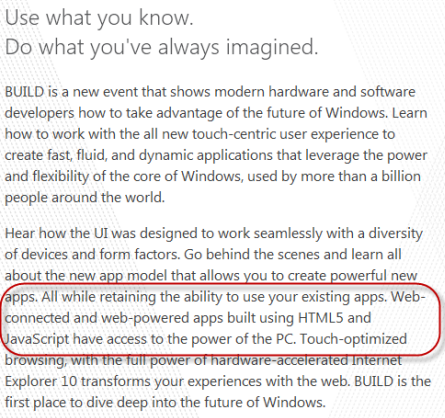Should developers be scared of what Windows 8 will bring?

In an attempt to make the operating system more 'finger friendly' Microsoft seems to be getting ready to move away from plaform technologies such as Win32, COM, MFC, ATL, .NET, Silverlight, and WPF and instead start embracing web-based technologies such as HTML5 and JavaScript to create immersive applications. Should Windows developers be scared?
First things first - Is Microsoft actually moving towards HTML and JavaScript? Well, we don't know for sure but seems so. During the Windows 8 demo at D9, Microsoft Vice President Julie Larson-Green, the person in charge of the Windows Experience, describes a new weather app and says "our new developer platform, which is, uhh, it's based on HTML5 and JavaScript." That's confirmation from a high up source and there's been no retraction from Microsoft since.
Note: Checkout this video at 3min 45sec to hear Larson-Green deliver this bombshell.
Ars Technica's Peter Bright has an excellent piece on this.
Windows developers have invested a lot of time, effort, and money into the platform. Over the years, they've learned Win32, COM, MFC, ATL, Visual Basic 6, .NET, WinForms, Silverlight, WPF. All of these technologies were, at one time or another, instrumental in creating desktop applications on Windows.
...
Hearing that Windows 8 would use HTML5 and JavaScript for its new immersive applications was, therefore, more than a little disturbing to Windows developers. Such a switch means discarding two decades of knowledge and expertise of Windows development-and countless hours spent learning Microsoft's latest-and-greatest technology-and perhaps just as importantly, it means discarding rich, capable frameworks and the powerful, enormously popular Visual Studio development environment, in favor of a far more primitive, rudimentary system with substantially inferior tools.
I encourage all developers out there to read Bright's article because if nothing else is should make everyone aware of just how transient 'skills' (even well-established ones) can be and how a paradigm shift (such as away from the mouse and towards the finger) can affect the entire ecosystem.
But should developers be worried here? After all, the official word from Microsoft is that developers need to sit tight and wait for the BUILD conference, at which point all will be revealed. However, even the BUILD website makes heavy mention of HTML 5 and JavaScript:
As someone who has spent a lot of time over the years at the codeface, I wouldn't be panicing right now? Why? Well, for a few reasons:
- This isn't the first time that Microsoft has tried integrating HTML with Windows ... technologies such as Active Desktop and the Channel Bar spring to mind.
- We're only talking about touch here, not the entire Windows dev ecosystem. And touch is a gamble - it might take off, it might wither on the vine. It's very early days. If you don't remember Active Desktop and the Channel Bar then that underlines my point.
- While the HTML5 + JavaScript combo isn't the best platform, it's not the end of the world if this is the default either. You can do some pretty cool stuff with these technologies and IE9 offers a good, fast springboard. It could work.
- Microsoft might have chosen to use HTML5 + JavaScript as a short-term solution to the touch problem If touch takes off I really can't see Microsoft continuing to limit it to HTML5 + JavaScript for long.
So, I don't think that there's anything to panic about. It's early days.
